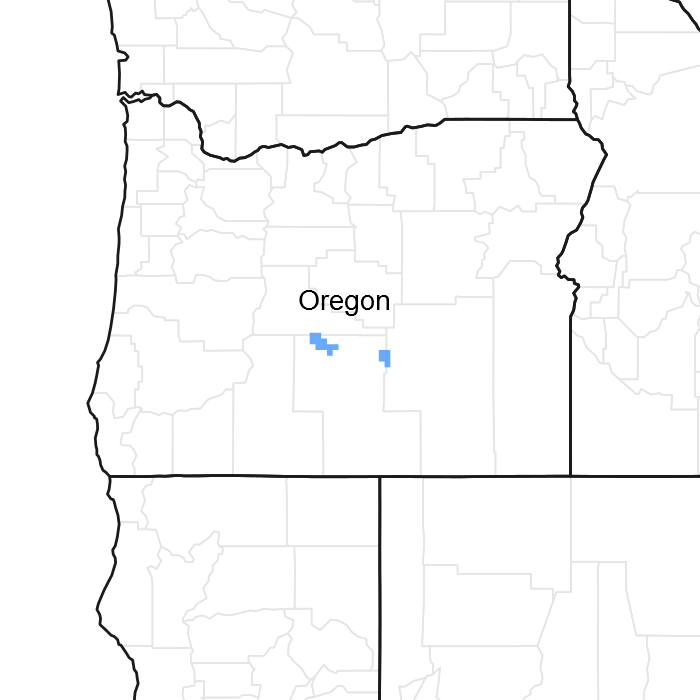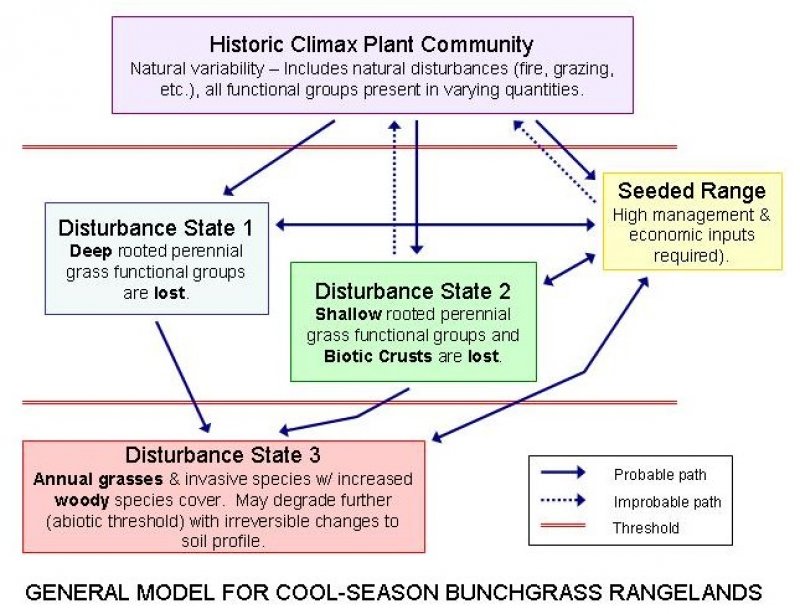
Natural Resources
Conservation Service
Ecological site R021XY425OR
JUNIPER-PINE LAVALANDS 10-12 PZ
Accessed: 12/21/2025
General information
Provisional. A provisional ecological site description has undergone quality control and quality assurance review. It contains a working state and transition model and enough information to identify the ecological site.

Figure 1. Mapped extent
Areas shown in blue indicate the maximum mapped extent of this ecological site. Other ecological sites likely occur within the highlighted areas. It is also possible for this ecological site to occur outside of highlighted areas if detailed soil survey has not been completed or recently updated.
Table 1. Dominant plant species
| Tree |
Not specified |
|---|---|
| Shrub |
Not specified |
| Herbaceous |
Not specified |
Physiographic features
Table 2. Representative physiographic features
| Landforms |
(1)
Lava plain
|
|---|---|
| Flooding frequency | None |
| Ponding frequency | None |
| Elevation | 4,000 – 5,200 ft |
| Slope | 1 – 50% |
| Aspect | Aspect is not a significant factor |
Climatic features
Summer thunderstorms and summer frosts may occur.
Table 3. Representative climatic features
| Frost-free period (average) | 60 days |
|---|---|
| Freeze-free period (average) | 90 days |
| Precipitation total (average) | 12 in |
Figure 2. Monthly average minimum and maximum temperature
Influencing water features
Soil features
Ecological dynamics
Juniper and curleaf mountian mahogany dominate the overstory as an open stand which is quite variable depending on soil and rock content.
Severe crown fires remove the overstory. Recovery after such fires can be very slow. Sites with more lava flow material are more likely to have limited burming of the overstory - lightning strikes may only affect individual trees. The post fire state is treeless, with rabbitbrush and bunchgrasses, a weedy forb/cheatgrass mix, and scatterred remnant shrubs.
State and transition model

More interactive model formats are also available.
View Interactive Models
More interactive model formats are also available.
View Interactive Models
Click on state and transition labels to scroll to the respective text
Ecosystem states
State 1 submodel, plant communities
State 1
HCPC, FEID-PSSP6/ARTRV-CELE3/PIPO
Community 1.1
HCPC, FEID-PSSP6/ARTRV-CELE3/PIPO
Juniper and ponderosa pine dominate the overstory. Curlleaf mountain mahogany is abundant and dominates the midstory. A mix of low understory shrubs includes bitterbrush, mountain big sagebrush, wax currant, gray rabbitbrush, prickly granite gilia and desertsweet (fernbush). A variety of grasses are present including Idaho fescue, bluebunch wheatgrass, sandberg bluegrass, western needlegrass and Ross sedge (grass-like). Forbs are minor in the stand such as tall cinquefoil, penstemon, phacelia, violet, buttercup, and low larkspur. Cover of all species varies greatly from place to place due to the variability of soil and rock on the landscape.
Figure 3. Annual production by plant type (representative values) or group (midpoint values)
Table 4. Annual production by plant type
| Plant type | Low (lb/acre) |
Representative value (lb/acre) |
High (lb/acre) |
|---|---|---|---|
| Grass/Grasslike | 185 | 216 | 248 |
| Shrub/Vine | 90 | 146 | 203 |
| Tree | 36 | 56 | 77 |
| Forb | 23 | 34 | 45 |
| Total | 334 | 452 | 573 |
Figure 4. Plant community growth curve (percent production by month). OR5621, D21 Juniper Sites 8-16. D21 Juniper Sites 8-16 pz RPC Growth Curve.
| Jan | Feb | Mar | Apr | May | Jun | Jul | Aug | Sep | Oct | Nov | Dec |
|---|---|---|---|---|---|---|---|---|---|---|---|
| J | F | M | A | M | J | J | A | S | O | N | D |
| 0 | 0 | 0 | 10 | 30 | 40 | 20 | 0 | 0 | 0 | 0 | 0 |
Additional community tables
Table 5. Community 1.1 plant community composition
| Group | Common name | Symbol | Scientific name | Annual production (lb/acre) | Foliar cover (%) | |
|---|---|---|---|---|---|---|
|
Grass/Grasslike
|
||||||
| 1 | Dominant deep rooted perennial grasses | 180–225 | ||||
| Idaho fescue | FEID | Festuca idahoensis | 90–113 | – | ||
| bluebunch wheatgrass | PSSPS | Pseudoroegneria spicata ssp. spicata | 90–113 | – | ||
| 5 | Other perennial grasses | 5–23 | ||||
| mountain big sagebrush | ARTRV | Artemisia tridentata ssp. vaseyana | 32–40 | – | ||
| curl-leaf mountain mahogany | CELE3 | Cercocarpus ledifolius | 8–16 | – | ||
| antelope bitterbrush | PUTR2 | Purshia tridentata | 3–5 | – | ||
| western needlegrass | ACOC3 | Achnatherum occidentale | 0–5 | – | ||
| Thurber's needlegrass | ACTH7 | Achnatherum thurberianum | 0–5 | – | ||
| Ross' sedge | CARO5 | Carex rossii | 0–5 | – | ||
| squirreltail | ELEL5 | Elymus elymoides | 0–5 | – | ||
| prairie Junegrass | KOMA | Koeleria macrantha | 0–5 | – | ||
| Sandberg bluegrass | POSE | Poa secunda | 0–5 | – | ||
| wax currant | RICE | Ribes cereum | 2–3 | – | ||
| desert sweet | CHMI2 | Chamaebatiaria millefolium | 2–3 | – | ||
| rubber rabbitbrush | ERNAS | Ericameria nauseosa ssp. nauseosa var. salicifolia | 0–2 | – | ||
| oceanspray | HODI | Holodiscus discolor | 0–2 | – | ||
|
Forb
|
||||||
| 7 | Dominant perennial forbs | 18–36 | ||||
| common yarrow | ACMI2 | Achillea millefolium | 5–9 | – | ||
| Wyoming Indian paintbrush | CALI4 | Castilleja linariifolia | 5–9 | – | ||
| beardtongue | PENST | Penstemon | 5–9 | – | ||
| cinquefoil | POTEN | Potentilla | 5–9 | – | ||
| 9 | Other perennial forbs | 5–9 | ||||
| phacelia | PHACE | Phacelia | 0–5 | – | ||
| buttercup | RANUN | Ranunculus | 0–5 | – | ||
| violet | VIOLA | Viola | 0–5 | – | ||
|
Shrub/Vine
|
||||||
| 11 | Dominant evergreen shrubs | 45–113 | ||||
| mountain big sagebrush | ARTRV | Artemisia tridentata ssp. vaseyana | 45–113 | – | ||
| 13 | Dominant deciduous (or 1/2 shrubs) shrubs | 23–45 | ||||
| curl-leaf mountain mahogany | CELE3 | Cercocarpus ledifolius | 23–45 | – | ||
| 14 | Sub-dominant deciduous (or 1/2 shrubs) shrubs | 14–23 | ||||
| antelope bitterbrush | PUTR2 | Purshia tridentata | 9–14 | – | ||
| desert sweet | CHMI2 | Chamaebatiaria millefolium | 5–9 | – | ||
| 15 | Other shrubs | 5–14 | ||||
| rubber rabbitbrush | ERNA10 | Ericameria nauseosa | 0–5 | – | ||
| oceanspray | HODI | Holodiscus discolor | 0–5 | – | ||
|
Tree
|
||||||
| 16 | Dominant evergreen trees | 32–68 | ||||
| western juniper | JUOC | Juniperus occidentalis | 23–45 | – | ||
| ponderosa pine | PIPO | Pinus ponderosa | 9–23 | – | ||
| 19 | Sub-dominant deciduous trees | 5–9 | ||||
| quaking aspen | POTR5 | Populus tremuloides | 5–9 | – | ||
Interpretations
Supporting information
Type locality
| Location 1: Lake County, OR | |
|---|---|
| General legal description | North edge of Fort Rock Valley (North of Devils Garden; also Derrick Cave area) |
Contributors
Hickman
Kennedy, Repp
Rangeland health reference sheet
Interpreting Indicators of Rangeland Health is a qualitative assessment protocol used to determine ecosystem condition based on benchmark characteristics described in the Reference Sheet. A suite of 17 (or more) indicators are typically considered in an assessment. The ecological site(s) representative of an assessment location must be known prior to applying the protocol and must be verified based on soils and climate. Current plant community cannot be used to identify the ecological site.
| Author(s)/participant(s) | |
|---|---|
| Contact for lead author | |
| Date | |
| Approved by | |
| Approval date | |
| Composition (Indicators 10 and 12) based on | Annual Production |
Indicators
-
Number and extent of rills:
-
Presence of water flow patterns:
-
Number and height of erosional pedestals or terracettes:
-
Bare ground from Ecological Site Description or other studies (rock, litter, lichen, moss, plant canopy are not bare ground):
-
Number of gullies and erosion associated with gullies:
-
Extent of wind scoured, blowouts and/or depositional areas:
-
Amount of litter movement (describe size and distance expected to travel):
-
Soil surface (top few mm) resistance to erosion (stability values are averages - most sites will show a range of values):
-
Soil surface structure and SOM content (include type of structure and A-horizon color and thickness):
-
Effect of community phase composition (relative proportion of different functional groups) and spatial distribution on infiltration and runoff:
-
Presence and thickness of compaction layer (usually none; describe soil profile features which may be mistaken for compaction on this site):
-
Functional/Structural Groups (list in order of descending dominance by above-ground annual-production or live foliar cover using symbols: >>, >, = to indicate much greater than, greater than, and equal to):
Dominant:
Sub-dominant:
Other:
Additional:
-
Amount of plant mortality and decadence (include which functional groups are expected to show mortality or decadence):
-
Average percent litter cover (%) and depth ( in):
-
Expected annual annual-production (this is TOTAL above-ground annual-production, not just forage annual-production):
-
Potential invasive (including noxious) species (native and non-native). List species which BOTH characterize degraded states and have the potential to become a dominant or co-dominant species on the ecological site if their future establishment and growth is not actively controlled by management interventions. Species that become dominant for only one to several years (e.g., short-term response to drought or wildfire) are not invasive plants. Note that unlike other indicators, we are describing what is NOT expected in the reference state for the ecological site:
-
Perennial plant reproductive capability:
Print Options
Sections
Font
Other
The Ecosystem Dynamics Interpretive Tool is an information system framework developed by the USDA-ARS Jornada Experimental Range, USDA Natural Resources Conservation Service, and New Mexico State University.
Click on box and path labels to scroll to the respective text.